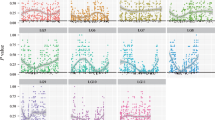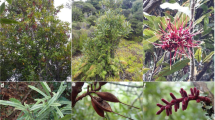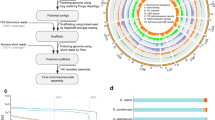Abstract
Explaining the origin and evolutionary dynamics of the genetic architecture of adaptation is a major research goal of evolutionary genetics. Despite controversy surrounding success of the attempts to accomplish this goal, a full understanding of adaptive genetic variation necessitates knowledge about the genomic location and patterns of dispersion for the genetic components affecting fitness-related phenotypic traits. Even with advances in next-generation sequencing technologies, the production of full genome sequences for non-model species is often cost-prohibitive, especially for tree species such as pines where genome size often exceeds 20 to 30 Gbp. We address this need by constructing a dense linkage map for foxtail pine (Pinus balfouriana Grev. & Balf.), with the ultimate goal of uncovering and explaining the origin and evolutionary dynamics of adaptive genetic variation in natural populations of this forest tree species. We utilized megagametophyte arrays (n = 76–95 megagametophytes/tree) from four maternal trees in combination with double digest restriction-site associated DNA sequencing (ddRADseq) to produce a consensus linkage map covering 98.58 % of the foxtail pine genome, which was estimated to be 1276 cM in length (95 % CI, 1174 to 1378 cM). A novel bioinformatic approach using iterative rounds of marker ordering and imputation was employed to produce single-tree linkage maps (507–17,066 contigs/map; lengths, 1037.40–1572.80 cM). These linkage maps were collinear across maternal trees, with highly correlated marker orderings (Spearman’s ρ>0.95). A consensus linkage map derived from these single-tree linkage maps contained 12 linkage groups along which 20,655 contigs were non-randomly distributed across 901 unique positions (n=23 contigs/position), with an average spacing of 1.34 cM between adjacent positions. Of the 20,655 contigs positioned on the consensus linkage map, 5627 had enough sequence similarity to contigs contained within the most recent build of the loblolly pine (Pinus taeda L.) genome to identify them as putative homologues containing both genic and non-genic loci. Importantly, all 901 unique positions on the consensus linkage map had at least one contig with putative homology to loblolly pine. When combined with the other biological signals that predominate in our data (e.g., correlations of recombination fractions across single trees), we show that dense linkage maps for non-model forest tree species can be efficiently constructed using next-generation sequencing technologies. We subsequently discuss the usefulness of these maps as community-wide resources and as tools with which to test hypotheses about the genetic architecture of local adaptation.



Similar content being viewed by others
References
Acheré V, Faivre-Rampant P, Jeandroz S, Besnard G, Markussen T, Aragones A, Fladung M, Ritter E, Favre J M (2004) A full saturated linkage map of Picea abies including AFLP, SSR, ESTP, 5S rDNA and morphological markers. Theor Appl Genet 108:1602–1613
Ahuja M R, Neale D B (2005) Evolution of genome size in conifers. Silvae Genetica 54:126–137
Akerman A, Bürger R (2014) The consequences of gene flow for local adaptation and differentiation: a two-locus two-deme model. Math Biol 68:1135–1198
Alberto F J, Aitken S N, Alia R, González-Martínez S C, Hanninen H, Kremer A, Lefevre F, Lenormand T, Yeaman S, Whetten R, Savolainen O (2013) Potential for evolutionary responses to climate change–evidence from tree populations. Glob Change Biol 19:1645–1661
Altschul S, Gish W, Miller W, Myers E, Lipman D (1990) Basic local alignment search tool. J Mol Biol 215:403–410
Anderson J T, Lee C R, Rushworth C A, Colautti R I, Mitchell-Olds T (2013) Genetic trade-offs and conditional neutrality contribute to local adaptation. Mol Ecol 22:699–708
Anderson J T, Wagner M R, Rushworth C A, Prasad K V S K, Mitchell-Olds T (2014) The evolution of quantitative traits in complex environments. Heredity 195:1353–1372
Antonovics J, Bradshaw A D (1970) Evolution in closely adjacent plant populations VIII. Clinal patterns at a mine boundary. Heredity 25:349–362
Bailey D K (1970) Phytogeography and taxonomy of Pinus subsection Balfourianae. Ann Mo Bot Gard 57:210–249
Cairney J, Pullman G S (2007) The cellular and molecular biology of conifer embryogenesis. New Phytol 176:511–536
Cartwright D A, Troggio M, Velasco R, Gutin A (2007) Genetic mapping in the presence of genotyping errors. Genetics 176:2521–2527
Chakravarti A, Lasher L K, Reefer J E (1991) A maximum-likelihood method for estimating genome length using genetic linkage data. Genetics 128:175–182
Cheema J, Dicks J (2009) Computational approaches and software tools for genetic linkage map estimation in plants. Brief Bioinform 10:595–608
Danecek P, Auton A , Abecasis G , Albers CA , Banks E , DePristo MA , Handsaker RE, Lunter G , Marth GT , Sherry ST, McVean G , Durbin R (2011) 1000 Genomes Project Analysis Group. The variant call format and VCFtools Bioinformatics 27:2156–2158
Davey J W, Blaxter M L (2010) RADSeq: next-generation population genetics. Brief Funct Genomics 9:416–423
Eckert A J, Hall B D (2006) Phylogeny, historical biogeography, and patterns of diversification for Pinus (Pinaceae): phylogenetic tests of fossil-based hypotheses. Mol Phylogenet Evol 40:166–182
Eckert A J, Tearse B R, Hall B D (2008) A phylogeographical analysis of the range disjunction for foxtail pine (Pinus balfouriana, Pinaceae): the role of pleistocene glaciation. Mol Ecol 17 :1983–1997
Eckert A J, Pande B, Ersoz E S, Wright M H, Rashbrook V K, Nicolet C M, Neale D B (2009) High-throughput genotyping and mapping of single nucleotide polymorphisms in loblolly pine (Pinus taedaL.) Tree Genet Genomes 5:225–234
Eckert A J, Bower A D, González-Martínez S C, Wegrzyn J L, Coop G, Neale DB (2010a) Back to nature: ecological genomics of loblolly pine (Pinus taeda, Pinaceae). Mol Ecol 19:3789–3805
Eckert A J, van Heerwaarden J, Wegrzyn J L, Nelson C D, Ross-Ibarra J, González-Martínez SC, Neale D B (2010b) Patterns of population structure and environmental associations to aridity across the range of loblolly pine (Pinus taeda L., Pinaceae). Genetics 185:969–982
Eckert A J, Wegrzyn J L, Liechty J D, Lee J M, Cumbie W P, Davis J M, Goldfarb B, Loopstra C A, Palle S R, Quesada T, Langley C H, Neale D B (2013) The evolutionary genetics of the genes underlying phenotypic associations for loblolly pine (Pinus taeda, Pinaceae). Genetics 112:4–12
Ellegren H, Sheldon B C (2008) Genetic basis of fitness differences in natural populations. Nature 452:169–175
Fisher R A (1918) The correlation between relatives on the supposition of Mendelian inheritance. Trans Roy Soc Edinb 52:399–433
Fournier-Level A, Wilczek A M, Cooper M D, Roe J L, Anderson J, Eaton D, Moyers B T, Petipas R H, Schaeffer R N, Pieper B, Reymond M, Koornneef M, Welch S M, Remington D L, Schmitt J (2013) Paths to selection on life history loci in different natural environments across the native range of Arabidopsis thaliana. Mol Ecol 22:3552–3566
Friedline C J, Franklin R B, McCallister S L, Rivera M C (2012) Bacterial assemblages of the eastern Atlantic Ocean reveal both vertical and latitudinal biogeographic signatures. Biogeosciences 9 :2177–2193
Gernandt D S, Lopez G G, Garcia S O, Liston A (2005) Phylogeny and classification of Pinus. Taxon 54:29–42
Ghodsi M, Hill C M, Astrovskaya I, Lin H, Sommer D D, Koren S, Pop M (2013) De novo likelihood-based measures for comparing genome assemblies. BMC Research Notes 6:334
Hackett C A, Broadfoot L B (2003) Effects of genotyping errors, missing values and segregation distortion in molecular marker data on the construction of linkage maps. Heredity 90:33–38
Hamming R W (1950) Error detecting and error correcting codes. Bell System Technical Journal 29:147–160
Hausmann N J, Juenger T E, Sen S, Stowe K A, Dawson T E, Simms E L (2005) Quantitative trait loci affecting δ 13C and response to differential water availability in Arabidopsis thaliana. Evolution 59:81–96
Hoffmann AA, Riesberg LH (2008) Revisiting the impact of inversions in evolution: from population genetic markers to drivers of adaptive shifts and speciation. Annu Rev Ecol Evol Syst 39:21–42
Houle D, Pelabon C, Wagner GP, Hansen TF (2011) Measurement and meaning in biology. Q Rev Biol 86:3–34
Ingvarsson P K, Street N R (2011) Association genetics of complex traits in plants. New Phytol 189:909–922
Kang B Y, Mann I K, Major J E, Rajora O P (2010) Near-saturated and complete genetic linkage map of black spruce (Picea mariana). BMC Genomics 11:515
Kawecki T J, Ebert D (2004) Conceptual issues in local adaptation. Ecol Lett 7:1225–1241
Keeling C I, Weisshaar S, Lin R P C, Bohlmann J (2008) Functional plasticity of paralogous diterpene synthases involved in conifer defense. Proc Natl Acad Sci USA 105:1085–1090
Kirkpatrick M, Barton N (2006) Chromosome inversions, local adaptation and speciation. Genetics 173:419–434
Koboldt D C, Steinberg K M, Larson D E, Wilson R K, Mardis E R (2013) The next-generation sequencing revolution and its impact on genomics. Cell 155:27–38
Kosambi D D (1944) The estimation of map distance from recombination values. Ann Eugen 12:172–175
Kubisiak T L, Nelson C D, Name W L, Stine M (1996) Comparison of rapd linkage maps constructed for a single longleaf pine from both haploid and diploid mapping populations. For Genet 3:203–211
Lange K, Boehnke M (1982) How many polymorphic marker genes will it take to span the human genome. Am J Hum Genet 128:842–845
Langmead B, Salzberg S L (2012) Fast gapped-read alignment with Bowtie 2. Nat Methods 9:357–359
Li H, Handsaker B, Subgroup GPDP, 10 (2009) The sequence alignment/map format and SAMtools. Bioinformatics 25:2078–2079
Limborg MT, Waples RK, Seeb JE, Seeb LW (2014) Temporally isolated lineages of pink salmon reveal unique signatures of selection on distinct pools of standing genetic variation. J Hered 105:741–751
Mackay J, Dean JFD, Plomion C, Peterson DG, Canovas FM, Pavy N, Ingvarsson PK, Savolainen O, Guevara MA, Fluch S, Vinceti B, Abarca D, Diaz-Sala C, Cervera MT (2012) Towards decoding the conifer giga-genome. Plant Mol Biol 80:555–569
Mantel N (1967) The detection of disease clustering and a generalized regression approach. Cancer Res 27:209–220
Martínez-García PJ, Stevens KA, Wegrzyn JL, Liechty J, Crepeau, M, Langley CH, Neale DB (2013) Combination of multipoint maximum likelihood (MML) and regression mapping algorithms to construct a high-density genetic linkage map for loblolly pine (Pinus taeda L.) Tree Genet Genomes 9:1529–1535
Mastrogiuseppe RJ, Mastrogiuseppe JD (1980) A study of Pinus balfouriana Grev. & Balf. (Pinaceae). Syst Bot 5:86–104
Mauricio R (2001) Mapping quantitative trait loci in plants: uses and caveats for evolutionary biology. Nat Rev Genet 2:370–381
Moritsuka E, Histaka Y, Tamura M, Uchiyama K, A W Tsmura Y, Tachida H (2012) Extended linkage disequilibrium in noncoding regions in a conifer, Cryptomeria japonica. Genetics 190:1145–1148
Morris RW, Spieth PT (1978) Sampling strategies for using female gametophytes to estimate heterozygosity in conifers. Theor Appl Genet 51:217–222
Morton NE (1955) Sequential tests for the detection of linkage. Am J Hum Genet 7:277–318
Murray BG (1998) Nuclear DNA amounts in gymnosperms. Ann Bot 82:3–15
Neale DB, Kremer A (2011) Forest tree genomics: growing resources and applications. Nat Rev Genet 12:111–122
Neale DB, Wegrzyn JL, Stevens KA, Zimin AV, Puiu D et al (2014) Decoding the massive genome of loblolly pine using haploid DNA and novel assembly strategies. Genome Biology 15:R59
Nei M (1987) Molecular evolutionary genetics. Columbia University Press
Nelson CD, Nance WL, Doudrick RL (1993) A partial genetic linkage map of slash pine (Pinus elliottii Engelm. var. elliottii) based on random amplified polymorphic DNA. Theor Appl Genet 87:145–151
Neves LG, Davis JM, Barbazuk WB, M K (2014) A high-density gene map of loblolly pine (Pinus taeda L.) based on exome sequence capture genotyping. G3 4:29–37
Nystedt B, Street NR, Wetterbom A, Zuccolo A, Lin YC et al (2013) The Norway spruce genome sequence and conifer genome evolution. Nature 497:579–584
Oline DK, Mitton JB, Grant MC (2000) Population and subspecific genetic differentiation in the foxtail pine (Pinus balfouriana). Evolution 54:1813–1819
Pannell JR, Fields PD (2013) Evolution in subdivided plant populations: concepts, recent advances and future directions. New Phytol 201:417–432
Parchman T L, Gompert Z, Mudge J, Schilkey FD, Benkman CW, Buerkle CA (2012) Genome-wide association genetics of an adaptive trait in lodgepole pine. Mol Ecol 21:2991–3005
Pavy N, Pelgas B, Laroche J, Rigault P, Isabel N, Bousquet J (2012) A spruce gene map infers ancient plant genome reshuffling and subsequent slow evolution in the gymnosperm lineage leading to extant conifers. BMC Biology 10:84
Peterson BK, Weber JN, Kay EH, Fisher HS, Hoekstra HE (2012) Double digest RADseq: an inexpensive method for de novo SNP discovery and genotyping in model and non-model species. PLoS ONE 7: e37
Pfender WF, Saha MC, Johnson EA, Slabaugh MB (2011) Mapping with RAD (restriction-site associated DNA) markers to rapidly identify QTL for stem rust resistance in Lolium perenne. Theor Appl Genet 122:1467–1480
R Core Team (2013) R: a language and environment for statistical computing. R Foundation for Statistical Computing, Vienna. URL http://www.R-project.org
Ritland K, Krutovsky KV, Tsumura Y, Pelgas B, Isabel N, Bousquet J (2011) Genetic mapping in conifers. In: Plomion C, Bousquet J, Kole C (eds) Genetics, Genomics and Breeding of Conifers. CRC Press, New York, pp 196–238
Rousseeuw P J (1987) Silhouettes: a graphical aid to the interpretation and validation of cluster analysis. J Comput Appl Math 20:53–65
Scheet P, Stephens M (2006) A fast and flexible statistical model for large-scale population genotype data: applications to inferring missing genotypes and haplotypic phase. Am J Hum Genet 78:629–644
Spearman C (1904) The proof and measurement of association between two things. Am J Psychol 15:72–101
Stevison LS, Hoehn KB, Noor MAF (2011) Effects of inversions on within- and between-species recombination and divergence. Genome Biol Evol 3:830–841
Studer A, Zhao Q, Ross-Ibarra J, Doebley J (2011) Identificaiton of a functinal transposon insertion in the maize domestication gene tb1. Nat Genet 43:1160–1163
Sturtevant AH (1913) The linear arrangement of six sex-linked factors in Drosophila, as shown by their mode of association. J Exp Zool 14:43–59
Supek F, Bosnjak M, Skunca N, Smuc T (2011) REVIGO summarizes and visualizes long lists of gene ontology terms. PLoS ONE 6: e21
Tani N, Takahashi T, Iwata H, Mukai Y, Ujino-Ihara T et al (2003) A consensus linkage map for sugi (Cryptomeria japonica) from two pedigrees, based on microsatellites and expressed sequence tags. Genetics 165:1551–1568
Travis S E, Ritland K, Whitham TG, Keim P (1998) A genetic linkage map of pinyon pine (Pinus edulis) based on amplified fragment length polymorphisms. Theor Appl Genet 97:871–880
Tulsieram LK, Glaubitz JC, Kiss G, Carlson JE (1992) Singletree genetic linkage mapping in conifers using haploid DNA from megagametophytes. Biotechnology 10:3–34
Van Ooijen JW (2011) Multipoint maximum likelihood mapping in a full-sib family of an outbreeding species. Genet Res 93:343– 349
Ward J, Bhangoo J, Fernandez-Fernandez F, Moore P, Swanson J, Viola R, Velasco R, Bassil N, Weber C, Sargent D (2013) Saturated linkage map construction in Rubus idaeus using genotyping by sequencing and genome-independent imputation. BMC Genomics 14:2
Ward JHJ (1963) Hierarchical grouping to optimize an objective function. J Am Stat Assoc 58:236–244
White TL, Adams WT, Neale DB (2007) Forest genetics. CABI Publishing, Cambridge
Willyard A, Syring J, Gernandt D, Liston A (2007) Cronn R, Fossil calibration of molecular divergence in Pinus: inferences for ages and mutation rates. Mol Biol Evol 24:90–101
Wu Y, Bhat PR, Close TJ, Lonardi S (2008a) Efficient and accurate construction of genetic linkage maps from the minimum spanning tree of a graph. PLoS Genetics 4:e1000
Wu Y, Close TJ, Lonardi S (2008b) On the accurate construction of consensus genetic maps. Computational Systems and Bioinformatics Conference 7:285–296
Yeaman S (2013) Genomic rearrangements and the evolution of clusters of locally adaptive loci. Proc Natl Acad Sci USA 110:E1743–E1751
Yeaman S, Whitlock MC (2011) The genetic architecture of adaptation under migration-selection balance. Evolution 65:1897–1911
Acknowledgments
The authors would like to thank the staff at the USDA Institute of Forest Genetics, the VCU Nucleic Acids Research Facility, and the VCU Center for High Performance Computing. In addition, we would like to thank Tom Blush and Tom Burt for help in obtaining seeds. Funding for this project was made available to AJE via start-up funds from Virginia Commonwealth University. CJF was supported by the National Science Foundation (NSF) National Plant Genome Initiative (NPGI): Postdoctoral Research Fellowship in Biology (PRFB) FY 2013 Award no. NSF-NPGI-PRFB-1306622.
Data Archiving Statement
Raw short read data are located in the NCBI Short Read Archive (accession number: PRJNA266319). The linkage map summary files, assembly used for read mapping and SNP calling, and VCF files are given as supporting documents (Files S1 - S3). The consensus linkage map is also available in the Comparative Mapping Database located at the Dendrome website (accession number: TG151). Source code for this manuscript and data analyses are located at http://www.github.com/cfriedline/foxtail_linkage.
Author information
Authors and Affiliations
Corresponding author
Additional information
Communicated by S. N. Aitken
This article is part of Topical collection on Adaptation
Electronic supplementary material
Below is the link to the electronic supplementary material.
Rights and permissions
About this article
Cite this article
Friedline, C.J., Lind, B.M., Hobson, E.M. et al. The genetic architecture of local adaptation I: the genomic landscape of foxtail pine (Pinus balfouriana Grev. & Balf.) as revealed from a high-density linkage map. Tree Genetics & Genomes 11, 49 (2015). https://doi.org/10.1007/s11295-015-0866-x
Received:
Revised:
Accepted:
Published:
DOI: https://doi.org/10.1007/s11295-015-0866-x




